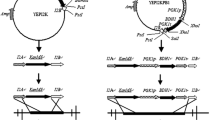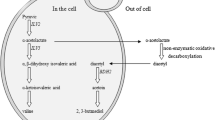Abstract
The characteristic buttery taste of diacetyl has long been a major problem in the brewing industry, and the foam stability of unpasteurized beer is often influenced by proteinase A (PrA), which is encoded by PEP4 and released from yeast cells into beer during brewing. A recombinant industrial brewer’s yeast strain that reduces the diacetyl content of beer and improves foam stability was constructed. We constructed a PGK1p-ILV5-PGK1t expression cassette, which was introduced into one of the PEP4 alleles via PCR-mediated homologous recombination. Then, the second PEP4 allele was disrupted using the Cre-loxP recombination system, and the recombinant strain was designated as S-CSIK12. The results show that the diacetyl production of S-CSIK12 is always lower than that of the host strain at all stages of beer fermentation. In addition, brewing with S-CSIK12 reduced the PrA activity of the final beer by 44 % compared with that using the wild-type strain. The head retention of the beer brewed with S-CSIK12 (260 ± 2 s) was better than that of the host strain S-6 (212 ± 3 s). Considering that more PrA is released from yeast cells during the final stage of main fermentation and that the timing of yeast cropping is determined by diacetyl reduction, brewing with strains that have low diacetyl production also reduced the PrA activity of the beer and improved its head retention. The present study provides reference for the brewing industry as well as research on the diacetyl reduction and foam stability of beer.






Similar content being viewed by others
Abbreviations
- PrA:
-
Proteinase A
- PEP4:
-
A kind of gene that encodes proteinase A
- ILV5:
-
A kind of gene that encodes reductoisomerase
- RI:
-
Acetohydroxyacid reductoisomerase
- ILV pathway:
-
Isoleucine–valine pathway
- ALDC:
-
α-Acetolactate decarboxylase
- ILV2:
-
A kind of gene that encodes acetolactate synthase I/II/III large subunit
- ILV3:
-
A kind of gene that encodes dihydroxy-acid dehydratase
- ILV6:
-
A kind of gene that encodes acetolactate synthase I/III small subunit
- LTP1:
-
Lipid transfer protein 1
- GPD1:
-
A kind of gene that encodes glycerol-3-phosphate dehydrogenase
- ROX:
-
Reference dye for real-time PCR
- HK:
-
Hexokinase
- Pfk:
-
Phosphofructokinase
- PYKi:
-
Pyruvate kinase
- S-6:
-
Wild-type industrial brewer’s yeast
- S-CSK10:
-
Two PEP4 allele disruption strain
- S-CSIK12:
-
Two PEP4 allele disruption and ILV5 overexpression strain
References
Saison D, De Schutter DP, Uyttenhove B, Delvaux F, Delvaux FR (2009) Contribution of staling compounds to the aged flavour of lager beer by studying their flavour thresholds. Food Chem 114(4):1206–1215
Meilgaard M (1975) Flavor chemistry of beer. II. Flavor and threshold of 239 aroma volatiles. Tech Q Master Brew Assoc Am 12(3):151–168
Haukeli A, Lie S (1978) Conversion of α-acetolactate and removal of diacetyl: a kinetic study. J Inst Brew 84:85–89
Wang Z-Y, He X-P, Liu N, Zhang B-R (2008) Construction of self-cloning industrial brewing yeast with high-glutathione and low-diacetyl production. Int J Food Sci Technol 43(6):989–994
Yamano S, Tanaka J, Inoue T (1994) Cloning and expression of the gene encoding [alpha]-acetolactate decarboxylase from Acetobacter aceti ssp. xylinum in brewer’s yeast. J Biotechnol 32(2):165–171
Blomqvist K, Suihko ML, Knowles J, Penttilä M (1991) Chromosomal integration and expression of two bacterial α-acetolactate decarboxylase genes in brewer’s yeast. Appl Environ Microbiol 57(10):2796–2803
Fujii T, Kondo K, Shimizu F, Sone H, Tanaka J, Inoue T (1990) Application of a ribosomal DNA integration vector in the construction of a brewer’s yeast having alpha-acetolactate decarboxylase activity. Appl Environ Microbiol 56(4):997–1003
Sone H, Fujii T, Kondo K, Shimizu F, Tanaka J, Inoue T (1988) Nucleotide sequence and expression of the Enterobacter aerogenes alpha-acetolactate decarboxylase gene in brewer’s yeast. Appl Environ Microbiol 54(1):38–42
Duong CT, Strack L, Futschik M, Katou Y, Nakao Y, Fujimura T, Shirahige K, Kodama Y, Nevoigt E (2011) Identification of Sc-type ILV6 as a target to reduce diacetyl formation in lager brewers’ yeast. Metab Eng 13(6):638–647
Villanueba K, Goossens E, Masschelein C (1990) Subthreshold vicinal diketone levels in lager brewing yeast fermentations by means of ILV5 gene amplification. J Am Soc Brew Chem 48:111–114
Villa K, Lee S, Goossens E, Debourg A, Masschelein C (1995) Control of vicinal diketone production by brewer’s yeast. I. Effects of ILV5 and ILV3 gene amplification on vicinal diketone production and ILV enzyme activity. J Am Soc Brew Chem 53:49–53
Brey SE, de Costa S, Rogers PJ, Bryce JH, Morris PC, Mitchell WJ, Stewart GG (2003) The effect of proteinase A on foam-active polypeptides during high and low gravity fermentation. J Inst Brew 109(3):194–202
Leisegang R, Stahl U (2005) Degradation of a foam-promoting barley protein by a proteinase from brewing yeast. J Inst Brew 111(2):112–117
Evans DE, Sheehan M, Stewart D (1999) The impact of malt derived proteins on beer foam quality. Part II. The influence of malt foam-positive proteins and non-starch polysaccharides on beer foam quality. J Inst Brew 105:171–178
Sorensen S, Bech L, Muldbjerg M, Beenfeldt T, Breddam K (1993) Barley lipid transfer protein 1 is involved in beer foam formation. Tech Quart 30:136–145
Evans DE, Bamforth CW (2008) Beer foam: achieving a suitable head: beer: a quality perspective. Academic Press, Burlington, pp 7–66
Lynch D, Bamforth C (2002) Measurement and characterization of bubble nucleation in beer. J Food Sci 67(7):2696–2701
Yokoi S, Shigyo T, Tamaki T (1996) A fluorometric assay for proteinase A in beer and its application for the investigation of enzymatic effects on foam stability. J Inst Brew 102(1):33–37
Cooper D, Stewart G, Bryce J (2000) Yeast proteolytic activity during high and low gravity wort fermentations and its effect on head retention. J Inst Brew 106(4):197–201
Wang ZY, He GQ, Ruan H, Liu ZS, Yang LF, Zhang BR (2006) Construction of proteinase A deficient transformant of industrial brewing yeast. Eur Food Res Technol 225(5–6):831–835
Wang ZY, He XP, Zhang BR (2007) Over-expression of GSH1 gene and disruption of PEP4 gene in self-cloning industrial brewer’s yeast. Int J Food Microbiol 119(3):192–199
Westphal V, Marcusson EG, Winther JR, Emr SD, van den Hazel HB (1996) Multiple pathways for vacuolar sorting of yeast proteinase A. J Biol Chem 271(20):11865
Woolford CA, Noble J, Garman JD, Tam MF, Innis M, Jones EW (1993) Phenotypic analysis of proteinase A mutants. Implications for autoactivation and the maturation pathway of the vacuolar hydrolases of Saccharomyces cerevisiae. J Biol Chem 268(12):8990–8998
Maddox I, Hough J (1970) Proteolytic enzymes of Saccharomyces carlsbergensis. Biochem J 117(5):843
Quilliam W, Hulse G, Cameron-Clarke A (2000) Yeast management and fermentation performance: a brewer’s perspective. Brewing yeast fermentation performance. Blackwell Science, Oxford, pp 189–200
Zhang HB, Ruan H, Li WF, Zhang W, Su ZR, He GQ, Chen QH (2011) Construction of recombinant industrial S. cerevisiae strain with barley lipid-transfer protein 1 secretion capability and lower PrA activity. Eur Food Res Technol 233(4):707–716
Liu XF, Wang ZY, Wang JJ, Lu Y, He XP, Zhang BR (2009) Expression of GAI gene and disruption of PEP4 gene in an industrial brewer’s yeast strain. Lett Appl Microbiol 49(1):117–123
Dillemans M, Goossens E, Goffin O, Masschelein C (1987) The amplification effects of the ILV5 gene on the production of vicinal diketones in Saccharomyces cerevisiae. J Am Soc Brew Chem 45(3):81–84
Gjermansen C, Nilsson-Tillgren T, Petersen JGL, Kielland-Brandt MC, Sigsgaard P, Holmberg S (1988) Towards diacetyl-less brewers’ yeast. Influence of ilv2 and ilv5 mutations. J Basic Microb 28(3):175–183
Kondo H, Yomo H, Furukubo S, Fukui N, Nakatani K, Kawasaki Y (1999) Advanced method for measuring proteinase A in beer and application to brewing. J Inst Brew 105(5):293–300
Sambrook J, Russell DW (2001) Molecular cloning: a laboratory manual, vol 2. CSHL press, New York
Lilly M, Lambrechts M, Pretorius I (2000) Effect of increased yeast alcohol acetyltransferase activity on flavor profiles of wine and distillates. Appl Environ Microbiol 66(2):744–753
Gueldener U, Heinisch J, Koehler G, Voss D, Hegemann J (2002) A second set of loxP marker cassettes for Cre-mediated multiple gene knockouts in budding yeast. Nucl Acid Res 30(6):e23–e23
Hao JG, Dong JJ, Speers RA, Shen W, Shan LJ, Fan W, Li Q, Gu GX, Chen J (2008) Construction of a single PEP 4 allele deletion in Saccharomyces carlsbergensis and a preliminary evaluation of its brewing performance. J Inst Brew 114(4):322–328
Daniel Gietz R, Woods RA (2002) Transformation of yeast by lithium acetate/single-stranded carrier DNA/polyethylene glycol method. Meth Enzymol 350:87–96
Cha HJ, Chae HJ, Choi SS, Yoo YJ (2000) Production and secretion patterns of cloned glucoamylase in plasmid-harboring and chromosome-integrated recombinant yeasts employing an SUC2 promoter. Appl Biochem Biotech 87(2):81–93
Saerens SMG, Verbelen P, Vanbeneden N, Thevelein J, Delvaux F (2008) Monitoring the influence of high-gravity brewing and fermentation temperature on flavour formation by analysis of gene expression levels in brewing yeast. Appl Microbiol Biotechnol 80(6):1039–1051
Zhang HB, Zhang HF, Chen QH, Ruan H, Fu ML, He GQ (2009) Effects of proteinase a on cultivation and viability characteristics of industrial Saccharomyces cerevisiae WZ65. J Zhejiang Univ Sci B 10(10):769–776
Chen QH, Liu XJ, Fu ML, Zhang HB (2010) Effect of PrA encoding gene-PEP4 deletion in industrial S. cerevisiae WZ65 on key enzymes in relation to the glycolytic pathway. Eur Food Res Technol 231(6):943–950
Bond U, Neal C, Donnelly D, James TC (2004) Aneuploidy and copy number breakpoints in the genome of lager yeasts mapped by microarray hybridisation. Curr Genet 45(6):360–370
Dickinson JR, Harrison SJ, Hewlins MJE (1998) An investigation of the metabolism of valine to isobutyl alcohol in Saccharomyces cerevisiae. J Biol Chem 273(40):25751–25756
Dickinson JR, Harrison SJ, Dickinson JA, Hewlins MJE (2000) An investigation of the metabolism of isoleucine to active amyl alcohol in Saccharomyces cerevisiae. J Biol Chem 275(15):10937–10942
Omura F (2008) Targeting of mitochondrial Saccharomyces cerevisiae Ilv5p to the cytosol and its effect on vicinal diketone formation in brewing. Appl Microbiol Biotechnol 78(3):503–513
Parr CL, Keates RAB, Bryksa BC, Ogawa M, Yada RY (2007) The structure and function of Saccharomyces cerevisiae proteinase A. Yeast 24(6):467–480
Hao X, Xiao DG, Zhang CY, Chen YF (2010) Influence of nutrients on proteinase A activity in draft beer during fermentation. Int J Food Sci Tech 45(6):1169–1174
Sampaio TL, Kennedy JA, Vasconcelos MC (2007) Use of microscale fermentations in grape and wine research. Am J Enol Vitic 58(4):534–539
Acknowledgments
The current study was financially supported by the program for Changjiang Scholars and Innovative Research Team in University (IRT1166), the National Natural Science Foundation of China (No.31271916).
Author information
Authors and Affiliations
Corresponding author
Rights and permissions
About this article
Cite this article
Lu, J., Dong, J., Wu, D. et al. Construction of recombinant industrial brewer’s yeast with lower diacetyl production and proteinase A activity. Eur Food Res Technol 235, 951–961 (2012). https://doi.org/10.1007/s00217-012-1821-9
Received:
Revised:
Accepted:
Published:
Issue Date:
DOI: https://doi.org/10.1007/s00217-012-1821-9




